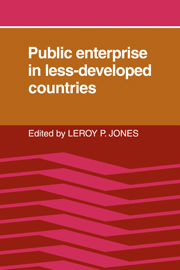Book contents
- Frontmatter
- Contents
- List of contributors
- List of figures and tables
- Preface
- 1 Introduction
- Part I Why public enterprise?
- Part II Principal-agent relationships: Who should control public enterprises?
- Part III How are decisions made in practice?
- Part IV How do public enterprises behave in international markets?
- 9 State-owned enterprises in the world economy: the case of iron ore
- 10 Changing patterns of ownership and integration in the international bauxite–aluminum industry
- 11 Public enterprise and manufactured exports in less-developed countries: institutional and market factors determining comparative advantage
- Part V How does risk alter public-enterprise decisions?
- Part VI How are incentive structures to be designed?
- Part VII How does public enterprise compare with other intervention mechanisms in overcoming particular problems?
9 - State-owned enterprises in the world economy: the case of iron ore
Published online by Cambridge University Press: 04 August 2010
- Frontmatter
- Contents
- List of contributors
- List of figures and tables
- Preface
- 1 Introduction
- Part I Why public enterprise?
- Part II Principal-agent relationships: Who should control public enterprises?
- Part III How are decisions made in practice?
- Part IV How do public enterprises behave in international markets?
- 9 State-owned enterprises in the world economy: the case of iron ore
- 10 Changing patterns of ownership and integration in the international bauxite–aluminum industry
- 11 Public enterprise and manufactured exports in less-developed countries: institutional and market factors determining comparative advantage
- Part V How does risk alter public-enterprise decisions?
- Part VI How are incentive structures to be designed?
- Part VII How does public enterprise compare with other intervention mechanisms in overcoming particular problems?
Summary
Only two or three decades ago, international trade was overwhelmingly in the hands of private firms. Today, however, state-owned enterprises hold a strong position in most raw materials, as well as some manufactured products; and the prospects are that this position may grow.
This chapter examines an industry in which state-owned enterprises have greatly enlarged their role in recent years, the world iron-ore industry. The chapter points to a number of conclusions about the effects of state-owned enterprises in international markets. Some conclusions may prove unique for the iron-ore industry, but others promise to apply more widely.
In industries such as iron-ore mining, where the fixed costs are high and where participants are limited in number, individual firms characteristically place considerable emphasis upon strategies that are designed to reduce their market risks. Until the 1970s, large private enterprises in these industries commonly tried to reduce such risks by creating vertically integrated linkages between mine and mill – that is to say, by internalizing the market for iron ore.
When state-owned enterprises became a major factor in the industry in the 1970s, the strategy of linking mines to mills continued to be prevalent wherever both could be located within the same national territory, but vertical integration across national borders became less common. Instead, state-owned enterprises sought other ways to achieve stability in international markets. How successful have they been in reducing the risks and uncertainties of these markets? What has been their effect on the structure of the international market itself? To answer these questions it is necessary first to review some key aspects of the changing structure of the industry.
- Type
- Chapter
- Information
- Public Enterprise in Less Developed Countries , pp. 169 - 188Publisher: Cambridge University PressPrint publication year: 1982
- 3
- Cited by

